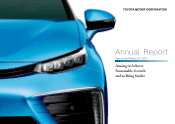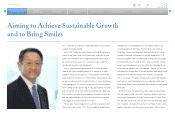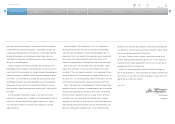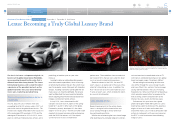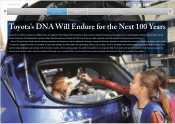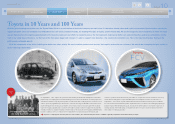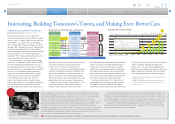Toyota 2014 Annual Report Download - page 8
Download and view the complete annual report
Please find page 8 of the 2014 Toyota annual report below. You can navigate through the pages in the report by either clicking on the pages listed below, or by using the keyword search tool below to find specific information within the annual report.
ANNUAL REPORT 2014
President’s MessagePresident’s Message
Overview of
Four Business Units
Overview of
Four Business Units
Special FeatureSpecial Feature
Review of OperationsReview of Operations
Consolidated Performance
Highlights
Consolidated Performance
Highlights
Management and
Corporate Information
Management and
Corporate Information
Investor InformationInvestor Information
Financial SectionFinancial Section
Page 8
NextPrev
ContentsSearchPrint
Engine work
(thermal
efficiency)
Fuel
Pump Exhaust Cooling Friction Loss reduction
Improved combustion and loss reduction lead to engines
with high thermal efficiency, low fuel consumption
Improved combustion
Powertrain Development and Production Engineering Building
How to Improve Thermal Efficiency
The Unit Center was established in March
2013 to handle Toyota’s unit-related techno-
logical development, manufacturing technol-
ogy development and production. The Center
aims to develop and rapidly commercialize
major powertrain components with best-in-
world competitiveness.
As a part of these efforts, Toyota opened a
new facility, the Powertrain Development and
Production Engineering Building, to facilitate
the development of next-generation
powertrains as the core of ever-better cars.
R&D and manufacturing technology staff at
this facility work on everything from the devel-
opment of basic technologies, such as materi-
als and processes, to entire vehicles and
major components. While maximizing devel-
opment efficiency, we aim to develop new
technologies with unprecedented speed.
Further innovation in
the conventional engine field
Toyota aims to further increase the environmental
performance of its vehicles with a series of newly
developed, highly fuel-efficient conventional gaso-
line engines that offer outstanding thermal effi-
ciency. The new engines leverage Toyota’s
sophisticated conventional engine technologies
as well as combustion and loss-reduction tech-
nologies accumulated through the development
of dedicated hybrid engines.
The key to improving the fuel economy of
engines is finding ways to use the thermal energy
stored in fuel to produce more “work” in an
engine. This is done by maximizing thermal effi-
ciency. Gasoline engines in hybrid vehicles
already boast high thermal efficiencies on par with
those of diesel engines. Toyota has achieved
a series of highly fuel-efficient conventional
engines with the same level of thermal efficiency
without assistance from a hybrid system. The
engines’ maximum thermal efficiency is world-
class, potentially improving fuel efficiency more
than 10%* compared with previous engines. For
example, the 1.3-liter gasoline engine in the series
offers 38% maximum thermal efficiency (Toyota
measurement) putting it on a world-class level for
a mass-produced gasoline engine. The new Vitz
model launched in April 2014 features this
1.3-liter gasoline engine and idling stop as stan-
dard, giving it an excellent fuel economy of 25.0
kilometers per liter*.
By 2015, Toyota plans to launch 14 high ther-
mal efficiency, fuel-efficient engines around the
world. The development of these engines was
made possible by the Unit Center, where an inte-
grated approach is taken to the creation of
product technologies and manufacturing technol-
ogies. Integrated development at the Unit Center
is a major force behind the move toward mass
production of Toyota’s fuel cell vehicle, what we
view as an ideal eco car.
As the eco car pioneer that brought the world
the hybrid vehicle, Toyota is working to improve
the environmental performance of all its cars.
* Under the Japanese Ministry of Land, Infrastructure, Transport
and Tourism’s (MLIT) JC08 test cycle
Developing and Commercializing Major Components with
Best-in-World Competitiveness
1.3-liter gasoline engine
offers 38% maximum
thermal efficiency
1.0-liter gasoline engine
offers 37% maximum
thermal efficiency
[1 of 4]
Overview of Four Business Units: Lexus International Toyota No. 1 Toyota No. 2 Unit Center

